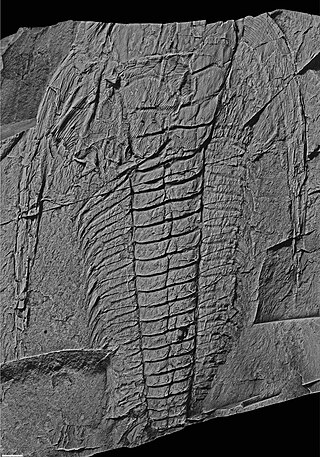
John William Salter was an English naturalist, geologist, and palaeontologist.
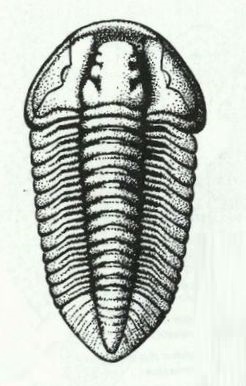
Flexicalymene Shirley, 1936. is a genus of trilobites belonging to the order Phacopida, suborder Calymenina and Family Calymenidae. Flexicalymene specimens can be mistaken for Calymene, Gravicalymene, Diacalymene and a few other Calymenina genera. They are used as an index fossil in the Ordovician. Ohio and North America are particularly known for being rich with Flexicalymene fossils.
Areia is a genus of cheirurid phacopid trilobite which existed during the Ordovician in what is now the Czech Republic. It was described by Barrande in 1872, and the type and only species is Areia bohemica.
Eccoptochiloides is a genus of trilobites in the order Phacopida, that existed during the upper Ordovician in what is now the Czech Republic. It was described by Prantl and Pribyl in 1947, and the type species is Eccoptochiloides tumescens, which was originally described under the genus Cheirurus by Barrande in 1852. The type locality was the Vinice Formation.
Eudolatites is a trilobite in the order Phacopida, that existed during the upper Ordovician in what is now the Czech Republic. It was described by Delo in 1935, and the type species is Eudolatites angelini, which was originally described under the genus Dalmanites by Barrande in 1852. The type locality was the Bohdalee Formation.
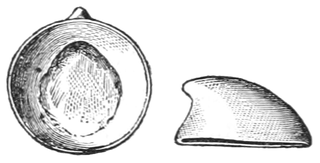
†Archinacellidae is an extinct family of paleozoic molluscs of uncertain position.

Pilina is an extinct genus of paleozoic monoplacophorans in the family Tryblidiidae.
Plumulites is an extinct genus of machaeridians, extinct annelid group.

Lingulella is a genus of phosphatic-shelled brachiopod. It is known from the Middle Cambrian Burgess Shale (Canada) to the Upper Ordovician Bromide Formation in North America. 346 specimens of Lingulella are known from the Greater Phyllopod bed, where they comprise 0.66% of the community.
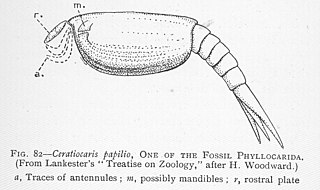
Ceratiocaris is a genus of paleozoic phyllocarid crustaceans whose fossils are found in marine strata from the Upper Ordovician until the genus' extinction during the Silurian. They are typified by eight short thoracic segments, seven longer abdominal somites and an elongated pretelson somite. Their carapace is slightly oval shaped; they have many ridges parallel to the ventral margin and possess a horn at the anterior end. They are well known from the Silurian Eramosa formation of Ontario, Canada.
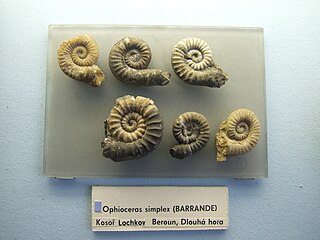
Ophioceras is a genus of closely coiled tarphycerid nautiloid cephalopods, the sole representatives of the family Ophidioceratidae, characterized by an evolute shell with narrow, subrounded, annulated whorls and a subcentral siphuncle composed of thin connecting rings that show no evidence of layering. The mature body chamber is strongly divergent and is the longest proportionally of any tarphycerid. The aperture has a deep hyponomic sinus and ocular sinuses, and so resembles some lituitids.
Concavodonta is an extinct genus of early bivalve in the extinct family Praenuculidae. The genus is one of three genera in the subfamily Concavodontinae. Concavodonta is known solely from late Ordovician, Caradoc epoch, fossils found in Europe and South America. The genus currently contains three accepted species, Concavodonta imbricata, Concavodonta ovalis and the type species Concavodonta ponderata.
Sinutropis is a genus of fossil sea snails, extinct euomphalid archaeogastropods from the Upper Silurian.
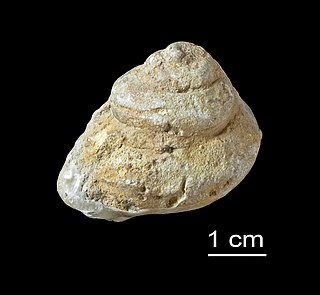
Holopea is an extinct genus of fossil sea snails, Paleozoic gastropod mollusks in the family Holopeidae.

Cyclopyge is a genus of small to average size trilobites that lived during the Ordovician. Like all members of the family Cyclopigidae, it has very large convex eyes, that cover most of the free cheeks, and in some species touch each other. The eyes almost touch the large glabella. The occipital ring has merged with the rest of the glabella. The glabella does not extend into a frontal thorn. The cephalon lacks genal spines. The 6 thorax segments have short pleurae. The pygidium is rather large, and often rather effaced. These are features that also occur in other Cyclopygidae, and are indications of a pelagic lifestyle.

Symphysops is a genus of trilobites of average size, belonging to the Cyclopygidae family. It had a cosmopolitan distribution and lived from the Middle to the Upper Ordovician. It has been found in Canada, China, the Czech Republic (Bohemia), Iran, Ireland, Kazakhstan, Poland, Morocco, Spain, Scotland and Wales. The name Symphysops refers to the fused eyes, common to the species of this genus. Some (sub)species of the cyclopygid genera Cyclopyge and Pricyclopyge share this character, but Symphysops uniquely combines the merged eye with a frontal thorn on the head and the "lower eyelid".

Furca is an extinct genus of marrellomorph arthropod known from the Sandbian stage of the Czech Republic, with a single currently described species, Furca bohemica. A tentative additional species, "Furca mauretanica": was proposed for specimens discovered in Morocco, but this species remains a nomen nudum until formally published, and probably belongs in a new separate genus.

The Illaenidae are a family of trilobites in the order Corynexochida. 223 currently accepted species in 24 genera are known from the Ordovician. Some scholars include the Panderiidae in the Illaenidae, but this is not generally supported.

Cryptolithus is a genus of extinct trinucleid trilobites that lived during the Ordovician period. They were mostly blind. They are found in the United States, Canada, Venezuela, the United Kingdom, France, the Czech Republic, Morocco and Turkey.

Rafinesquina is an extinct genus of large brachiopod that existed from the Darriwilian to the Ludlow epoch.














